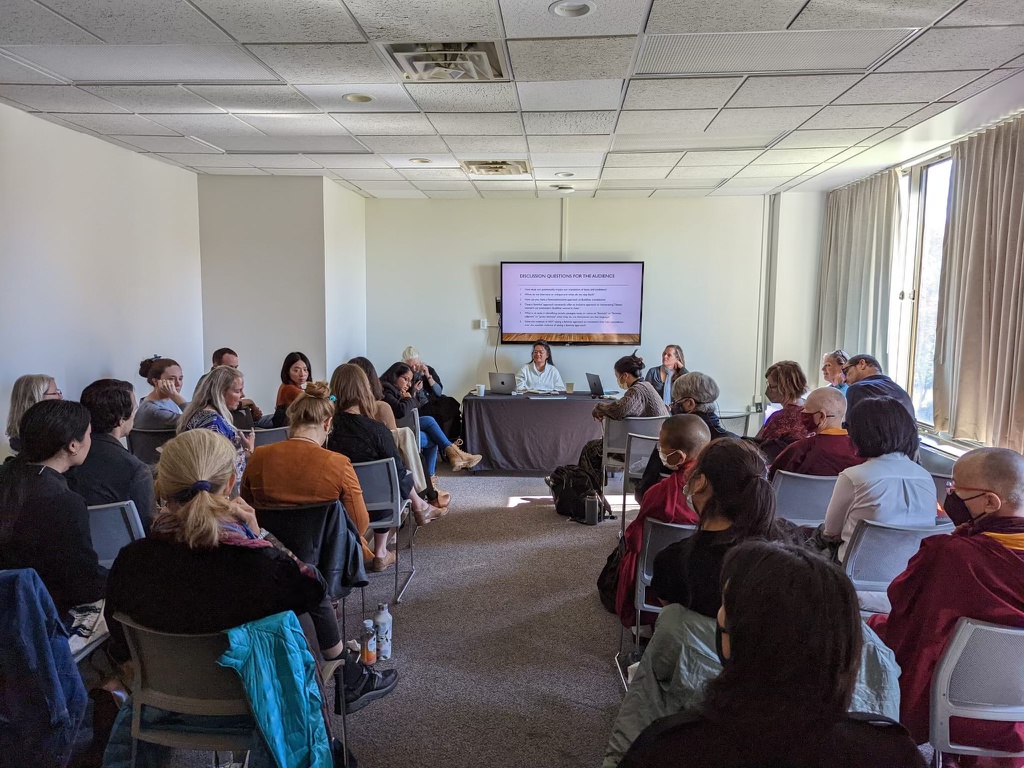On translation with Janet Gyatso, Dawa Lokyitsang, & Amy Langenberg, and the importance of Listening
This conversation took place as part of the second Lotsawa Translation Workshop at Northwestern University on Saturday, October 15, 2022. The theme of 2022 was “Celebrating Buddhist Women’s Voices in the Tibetan Tradition.”
The panel discussion “Inclusive/Feminist approaches to Buddhist translation” was hosted by Janet Gyatso (Harvard University), Amy Langenberg (Eckerd College), and myself (University of Colorado Boulder). In the room, there were Tibetan and Western nuns of Tibetan Buddhist traditions, Buddhist studies scholars, professors, translators, practitioners and graduate students from traditions across Asia, Tibetan Studies scholars and translators in religion and anthropology, Tibetan women scholars, writers, poets, translators, and editors from Tibet and across exile-diaspora, and editors of digital resources on Tibetan Buddhism.
The panel began with a short introduction of what Janet, Amy, and I (in this order) mean when we say “Inclusive/feminist approaches to Buddhist translations” and shared a list of questions to generate discussion for the audience.
Here is the audio of the session:
***
Some context: You will notice we mention Ani Choeyang a few times (a Tibetan nun who was studying at Emory University). She made an important comment in the previous key note session “Feminist Translation and Translation Studies: in Flux toward the Translational.” You can listen to Ani Choeyang at the 1:17:32 mark (click on the session and the audio will show below).
In her comment, Ani Choeyang says that her Tibetan Buddhist education as a nun is a source of pride but is a bit confused by conversations on sexual violence (primarily in Western Dharma centers of different traditions in the West) taking place at the conference. The topic of “Buddhist sexual violence” was brought up several times at the conference but without specificity as to who, which Dharma center, and what context. Just that it was happening and was wrong.
I spoke to Ani Choeyang afterwards and she said there seems to be a critique of sexual violence but she was confused by the ambiguous and homogenizing ways “Buddhist sexual violence” was being talked about. The lack of specificity seemed to imply that Buddhism itself was under scrutiny, which did not sit right with Ani Choeyang–hence her comment in defense of Buddhism to emphasize how gaining Tibetan Buddhist knowledge is a source of pride. It was an important critique of how the conversation on sexual violence lacked specificity. Her question to the speaker and the room asking for clarity went unanswered.
In our panel discussion, you can hear Ani Choeyang again at the 53:32 mark sharing two stories: one about blaming her mother for not being able to access Buddhist education in Tibet and realizing later in India that it was not her mother’s fault but due to difficult circumstances (of the political occupation and the securitization of Tibetan Buddhism in colonized Tibet under China). And second, a story about doing remote retreat and being harassed by a male heckler, during which she had wished she was a man. This too was another insightful comment by Ani Choeyang. The few who responded to Ani la spoke about the value of being born a woman and valuing girls. But Ani la was not making the point that she wanted to be re/born a man. Instead, she was highlighting how being a woman exposed her to certain vulnerabilities that are gendered. Highlighting how its men, not Buddhism that exposes women to these gendered vulnerabilities. This was the reason why I brought up Spivak’s “Can the Subaltern Speak?” (around the end) to emphasize how the subaltern, even when speaking, is not heard. This is why listening is so important because it is itself an inclusive practice in hearing.
Nonetheless, it was a insightful discussion session that I was glad to be part of. Also, this was the first conference themed around women in Tibetan Buddhism and/or literature that had the largest number of Tibetan women participants and presenters. This is way more than the standard one or two. That itself was a good demonstration of what inclusiveness could and should look like.
